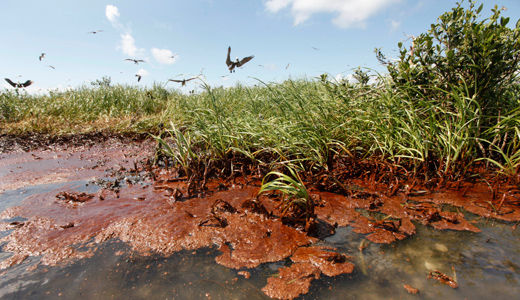
On August 4, scientists from the Louisiana Universities Marine Consortium released their annual measurement from the Gulf of Mexico’s dead zone – in part, the product of the infamous 2010 BP oil spill. The results were troubling. The area of oxygen deprivation in the sensitive ecosystem has been estimated at 5,008 square miles this year.
Though the current exacerbation of the issue is due to nitrogen and phosphorous pollution – the product of fertilizer runoff and wastewater discharges from treatment plants – the dead zone’s creation is largely owed to the spill that poisoned the Gulf four years ago, flooding it with 170 million gallons of oil.
In particular, the Gulf’s coral community is suffering, according to a new study by scientists at Penn State University in State College, Pa. Using 3D seismic data from the Bureau of Ocean Energy Management and identifying 488 habitats within a 25-mile radius of the original spill site, they found that coral life there shows extensive lingering damage from the spill, suggesting that the disaster’s footprint is much more severe than initially thought.
“This study very clearly shows that multiple coral communities, up to 13.7 miles from the spill site and at depths over 5,905 feet, were impacted by the spill,” said Charles Fisher, co-author of the study and professor of biology at Penn State. “One of the keys to coral’s usefulness as an indicator species is that the coral skeleton retains evidence of damage long after the oil that originally caused the damage is gone.”
Jane Lubchenco, an Oregon State University marine biologist and director of the National Oceanic and Atmospheric Administration, remarked, “The BP oil spill could have been much worse, but the caution is that we still don’t fully know the true extent of the damage. But there were likely acute impacts before the oil disappeared, and in fact, some of the oil that did come ashore continues to be suspended in the environment.”
Lead researcher of the Penn State study, Helen White, said most experts had previously linked coral damage to the oil spill, but added, “Now we can say it was definitely connected to the spill.” The paper the scientists published elaborated, reading, “Coral colonies are vital oases for marine life in the chilly ocean depths. The injured and dying coral today has bare skeleton, loose tissue, and is covered in heavy mucus and brown fluffy material.”
And experts have spotted yet another piece of the spill’s aftermath, which is its effect on insects, many of which play a vital role in maintaining the integrity of the ecosystem. Louisiana State University entomologist Linda Hooper-Bui said the real damage to bugs was likely done when Hurricane Isaac hit in 2012 and stirred up oil that had lain dormant on the ocean floor. This, said Hooper-Bui, affects the insects and spiders living in the marsh grasses nearby, some of which form the base of the area’s food chain.
Michael Blum, director of the Tulane/Xavier Center for Bioenvironmental Research, said, “During the spill, we were asking how long it would take to recover, and the prevailing notion was that we were looking at relatively short recovery times when focusing on coastal marsh and coastal ecosystems.” Essentially, that it would “rebound in one to three years and in five years there’d be no indications of the spill. But four years on, there’s still a pretty distinct signature of a response to the oil.”
Samantha Joye, a University of Georgia marine biologist, added that it could be a long time before scientists really have a handle on the ripple effect of the spill; the coral degradation, decline in insect population, and continuing growth of the dead zone are merely several aspects of the issue that have recently come to light. She said, “The long-term ecosystem impacts from the Deepwater Horizon oil spill are only beginning to be realized. Some areas have recovered well, but others remain significantly impacted. And the problem with this is that the [effects] are so heterogenerously distributed that long-term, system-scale monitoring is required to truly quantify the impacts.”
Photo: Nesting pelicans land as oil washes ashore – remnants of the 2010 BP oil spill – in Plaquemines Parish, Louisiana. The residual effects of the spill are negatively affecting everything from the coral reef to insect populations. Gerald Herbert/AP










